Simulation Performance of Temperature and Precipitation in the Yangtze River by Different Cumulus and Land Surface Schemes in RegCM4
Abstract
1. Introduction
2. Data and Methods
2.1. RegCM4 and Experimental Description
2.2. Data
2.3. Methodology
3. Results
3.1. Comprehensive Evaluation of the Physical Parameterization Scheme
3.2. Assessment of Climatological Performance
3.3. Performance Evaluation for Annual Cycle and Probability Density
4. Discussion
5. Conclusions
Supplementary Materials
Author Contributions
Funding
Institutional Review Board Statement
Informed Consent Statement
Data Availability Statement
Acknowledgments
Conflicts of Interest
References
- Giorgi, F.; Marinucci, M.-R. A Investigation of the Sensitivity of Simulated Precipitation to Model Resolution and Its Implications for Climate Studies. Mon. Weather Rev. 1996, 1, 148–166. [Google Scholar] [CrossRef]
- Bao, Y. Simulations of summer monsoon climate over East Asia with a Regional Climate Model (RegCM) using Tiedtke convective parameterization scheme (CPS). Atmos. Res. 2013, 134, 35–44. [Google Scholar] [CrossRef]
- Juneng, L.; Tangang, F.; Chung, J.-X.; Ngai, S.-T.; Tay, T.-W.; Narisma, G.; Cruz, F.; Phan-Van, T.; Ngo-Duc, T.; Santisirisomboon, J.; et al. Sensitivity of Southeast Asia rainfall simulations to cumulus and air-sea flux parameterizations in RegCM4. Clim. Res. 2016, 1, 59–77. [Google Scholar] [CrossRef]
- Ngo-Duc, T.; Tangang, F.-T.; Santisirisomboon, J.; Cruz, F.; Trinh-Tuan, L.; Nguyen-Xuan, T.; Phan-Van, T.; Juneng, L.; Narisma, G.; Singhruck, P.; et al. Performance evaluation of RegCM4 in simulating extreme rainfall and temperature indices over the CORDEX-Southeast Asia region. Int. J. Climatol. 2017, 3, 1634–1647. [Google Scholar] [CrossRef]
- Kalognomou, E.-A.; Lennard, C.; Shongwe, M.; Pinto, I.; Favre, A.; Kent, M.; Hewitson, B.; Dosio, A.; Nikulin, G.; Panitz, H. A Diagnostic Evaluation of Precipitation in CORDEX Models over Southern Africa. J. Clim. 2013, 23, 9477–9506. [Google Scholar] [CrossRef]
- Llopart, M.; Da Rocha, R.-P.; Reboita, M.; Cuadra, S. Sensitivity of simulated South America climate to the land surface schemes in RegCM4. Clim. Dyn. 2017, 11, 3975–3987. [Google Scholar] [CrossRef]
- Reboita, M.; Fernandez, J.; Pereira Llopart, M.; Porfirio, D.-R.-R.; Albertani Pampuch, L.; Cruz, F. Assessment of RegCM4.3 over the CORDEX South America domain: Sensitivity analysis for physical parameterization schemes. Clim. Res. 2014, 3, 215–234. [Google Scholar] [CrossRef]
- Zou, L.-W.; Qian, Y.; Zhou, T.-J.; Yang, B. Parameter Tuning and Calibration of RegCM3 with MIT–Emanuel Cumulus Parameterization Scheme over CORDEX East Asia Domain. J. Clim. 2014, 20, 7687–7701. [Google Scholar] [CrossRef]
- Gianotti, R.-L.; Eltahir, E.-A.-B. Regional Climate Modeling over the Maritime Continent. Part II: New Parameterization for Autoconversion of Convective Rainfall. J. Clim. 2014, 4, 1504–1523. [Google Scholar] [CrossRef]
- Cao, J.; Zhang, X.-N.; You, Y.-L.; Yang, R.-W. Applicability of cumulus convective parameter schemes in RegCM3 to the rainfall over the Longitudinal Range-Gorge Region. Chin. Sci. Bull. 2007, 2, 115–121. [Google Scholar] [CrossRef]
- Zou, L.-W.; Zhou, T.-J. Sensitivity of a regional ocean-atmosphere coupled model to convection parameterization over western North Pacific. J. Geophys. Res. Atmos. 2011, 116. [Google Scholar] [CrossRef][Green Version]
- Jinsong, P.; Guoqing, Z.; Kun, G. Comparisons of three convection parameterization schemes in regional climate simulations. Chin. J. Atmos. Sci. 2002, 2, 220–228. (In Chinese) [Google Scholar]
- Gao, X.-J.; Giorgi, F. Use of the RegCM system over East Asia: Review and perspectives. Engineering 2017, 5, 766–772. [Google Scholar] [CrossRef]
- Kang, S.; Im, E.-S.; Ahn, J.-B. The impact of two land-surface schemes on the characteristics of summer precipitation over East Asia from the RegCM4 simulations. Int. J. Climatol. 2014, 15, 3986–3997. [Google Scholar] [CrossRef]
- Li, Y.-B.; Tam, C.-Y.; Huang, W.-R.; Cheung, K.-K.-W.; Gao, Z.-Q. Evaluating the impacts of cumulus, land surface and ocean surface schemes on summertime rainfall simulations over East-to-southeast Asia and the western north Pacific by RegCM4. Clim. Dyn. 2016, 46, 2487–2505. [Google Scholar] [CrossRef]
- Dickinson, R.-E.; Henderson-Sellers, A.; Kennedy, J. Biosphere Atmosphere Transfer Scheme (BATS) Version 1e as Coupled to the NCAR Community Climate Model; NCAR Technical Note NCAR/TN-387+STR; National Center for Atmospheric Research: Boulder, CO, USA, 1993. [Google Scholar]
- Oleson, K.; Dai, Y.; Bonan, G.; Mike, B.; Dickinson, R.; Dirmeyer, P.; Hoffman, F.; Houser, P.; Levis, S.; Niu, G.; et al. Technical Description of the Community Land Model (CLM); NCAR Technical Note NCAR/TN-461+STR; National Center for Atmospheric Research: Boulder, CO, USA, 2004. [Google Scholar] [CrossRef]
- Shen, X.; Liu, B.; Lu, X.; Fan, G. Spatial and temporal changes in daily temperature extremes in China during 1960–2011. Theor. Appl. Climatol. 2017, 130, 933–943. [Google Scholar] [CrossRef]
- Liu, W.; Sun, W.; Huang, J.; Wen, H.; Huang, R. Excessive Rainfall Is the Key Meteorological Limiting Factor for Winter Wheat Yield in the Middle and Lower Reaches of the Yangtze River. Agronomy 2022, 1, 50. [Google Scholar] [CrossRef]
- Gao, X.-J.; Shi, Y.; Song, R.; Giorgi, F.; Wang, Y.; Zhang, D.-F. Reduction of future monsoon precipitation over China: Comparison between a high resolution RCM simulation and the driving GCM. Meteorol. Atmos. Phys. 2008, 100, 73–86. [Google Scholar] [CrossRef]
- Giorgi, F.; Coppola, E.; Solmon, F.; Mariotti, L.; Sylla, M.-B.; Bi, X.; Elguindi, N.; Diro, G.-T.; Nair, V.; Giuliani, G.; et al. RegCM4: Model description and preliminary tests over multiple CORDEX domains. Clim. Res. 2012, 52, 7–29. [Google Scholar] [CrossRef]
- Holtslag, A.-A.-M.; De Bruijn, E.-I.-F.; Pan, H. A High Resolution Air Mass Transformation Model for Short-Range Weather Forecasting. Mon. Weather Rev. 1990, 8, 1561–1575. [Google Scholar] [CrossRef]
- Zeng, X.-B.; Zhao, M.; Dickinson, R.-E. Intercomparison of Bulk Aerodynamic Algorithms for the Computation of Sea Surface Fluxes Using TOGA COARE and TAO Data. J. Clim. 1998, 10, 2628–2644. [Google Scholar] [CrossRef]
- Uppala, S.-M.; Dee, D.; Kobayashi, S.; Berrisford, P.; Simmons, A. Towards a climate data assimilation system: Status update of ERA-Interim. In ECMWF Newsletter, No.115; ECMWF: Reading, UK, 2008. [Google Scholar]
- Wu, J.; Gao, X.-J. A gridded daily observation dataset over China region and comparison with the other datasets. Chin. J. Geophys. 2013, 4, 1102–1111. (In Chinese) [Google Scholar]
- Shi, Y.; Wang, G.-L.; Gao, X.-J. Role of resolution in regional climate change projections over China. Clim. Dyn. 2018, 51, 2375–2396. [Google Scholar] [CrossRef]
- Mu, Q.; Jackson, C.-S.; Stoffa, P.-L. A multivariate empirical-orthogonal-function-based measure of climate model performance. J. Geophys. Res. Atmos. 2004, 109. [Google Scholar] [CrossRef]
- Harvey, L.; Wigley, T. Characterizing and comparing control-run variability of eight coupled AOGCMs and of observations. Part 1: Temperature. Clim. Dyn. 2003, 7, 619–646. [Google Scholar] [CrossRef]
- Im, E.-S.; Gutowski, W.-J., Jr.; Giorgi, F. Consistent changes in twenty-first century daily precipitation from regional climate simulations for Korea using two convection parameterizations. Geophys. Res. Lett. 2008, 35. [Google Scholar] [CrossRef]
- Diro, G.-T.; Rauscher, S.-A.; Giorgi, F.; Tompkins, A.-M. Sensitivity of seasonal climate and diurnal precipitation over Central America to land and sea surface schemes in RegCM4. Clim. Res. 2012, 52, 31–48. [Google Scholar] [CrossRef]
- Im, E.; Marcella, M.-P.; Eltahir, E.-A.-B. Impact of Potential Large-Scale Irrigation on the West African Monsoon and Its Dependence on Location of Irrigated Area. J. Clim. 2014, 3, 994–1009. [Google Scholar] [CrossRef]
- Alfieri, L.; Claps, P.; D’Odorico, P.; Laio, F.; Over, T.-M. An Analysis of the Soil Moisture Feedback on Convective and Stratiform Precipitation. J. Hydrometeorol. 2006, 2, 280–291. [Google Scholar] [CrossRef]
- Myoung, B.; Nielsen-Gammon, J.-W. The Convective Instability Pathway to Warm Season Drought in Texas. Part I: The Role of Convective Inhibition and Its Modulation by Soil Moisture. J. Clim. 2010, 17, 4461–4473. [Google Scholar] [CrossRef]
- Hauck, C.; Barthlott, C.; Krauss, L.; Kalthoff, N. Soil moisture variability and its influence on convective precipitation over complex terrain. Q. J. R. Meteorol. Soc. 2011, 137, 42–56. [Google Scholar] [CrossRef]
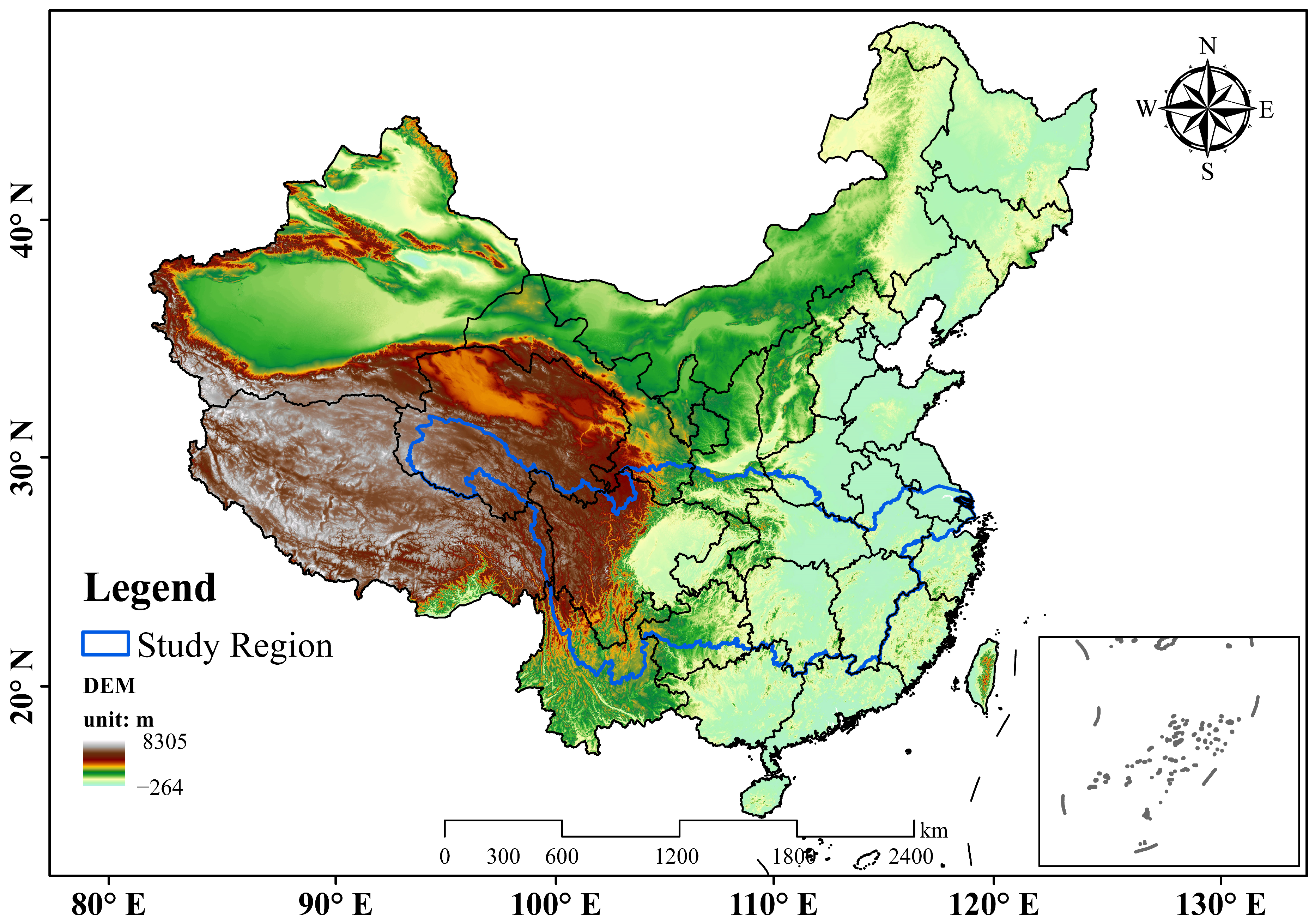
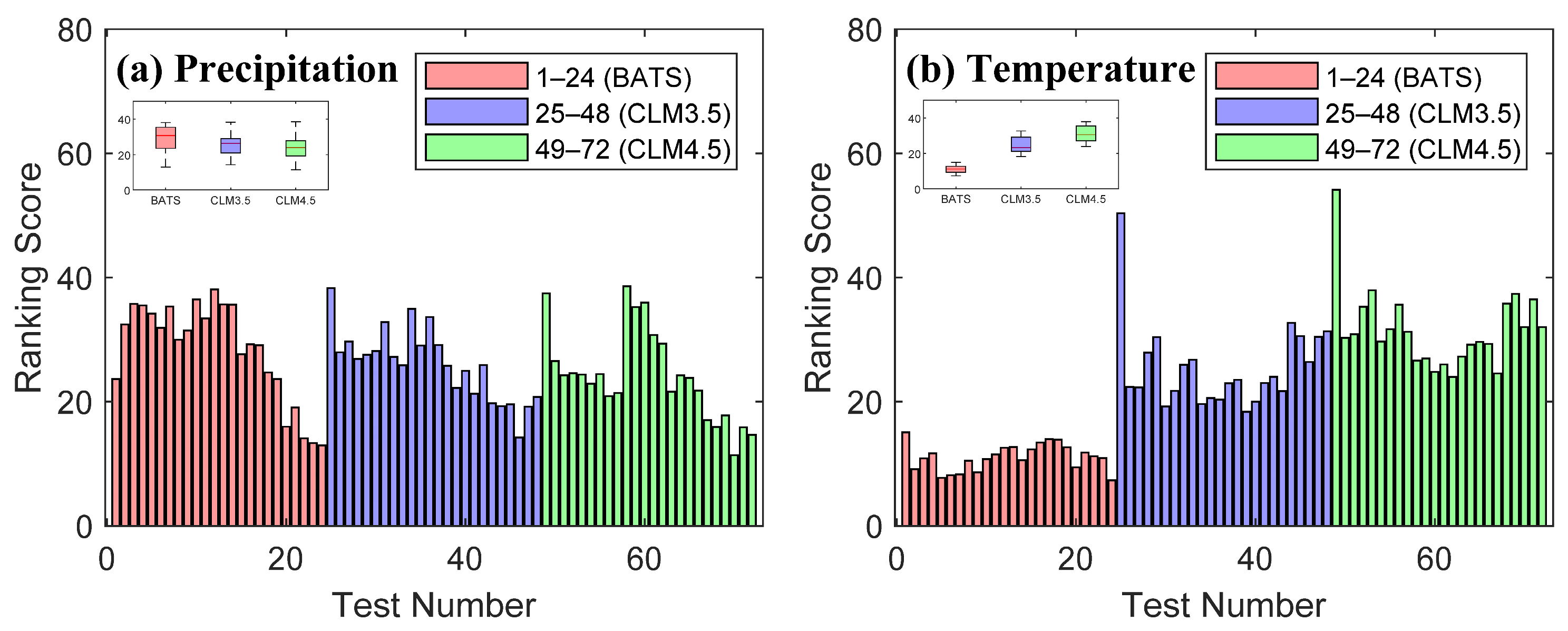
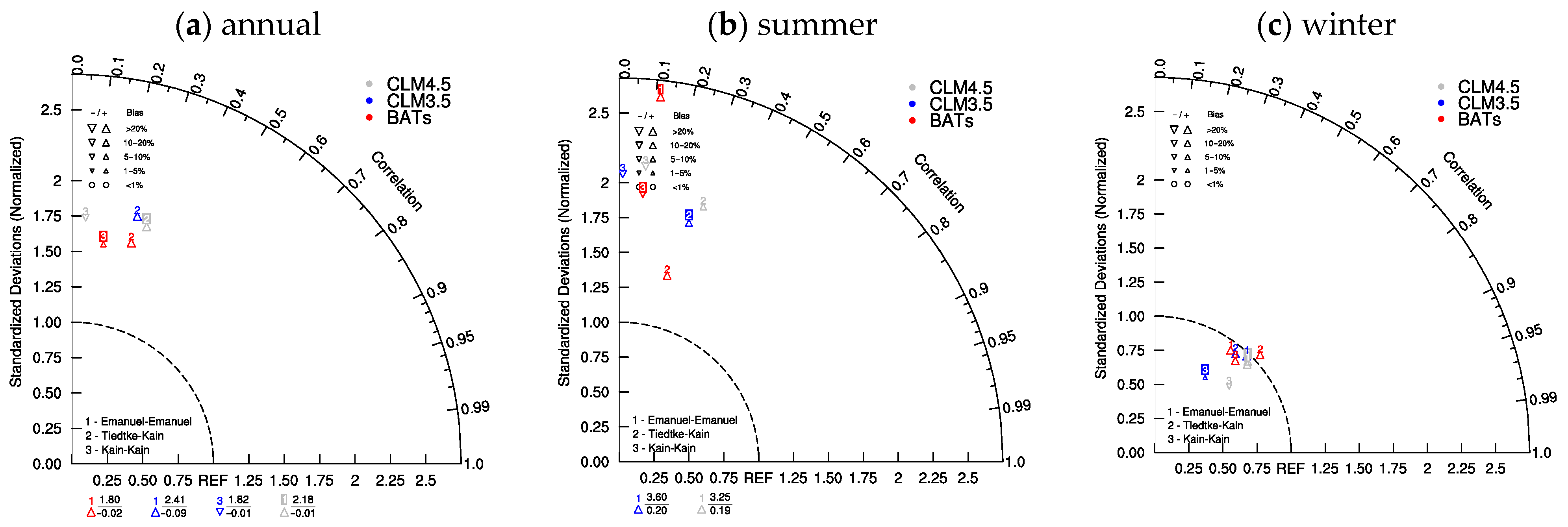


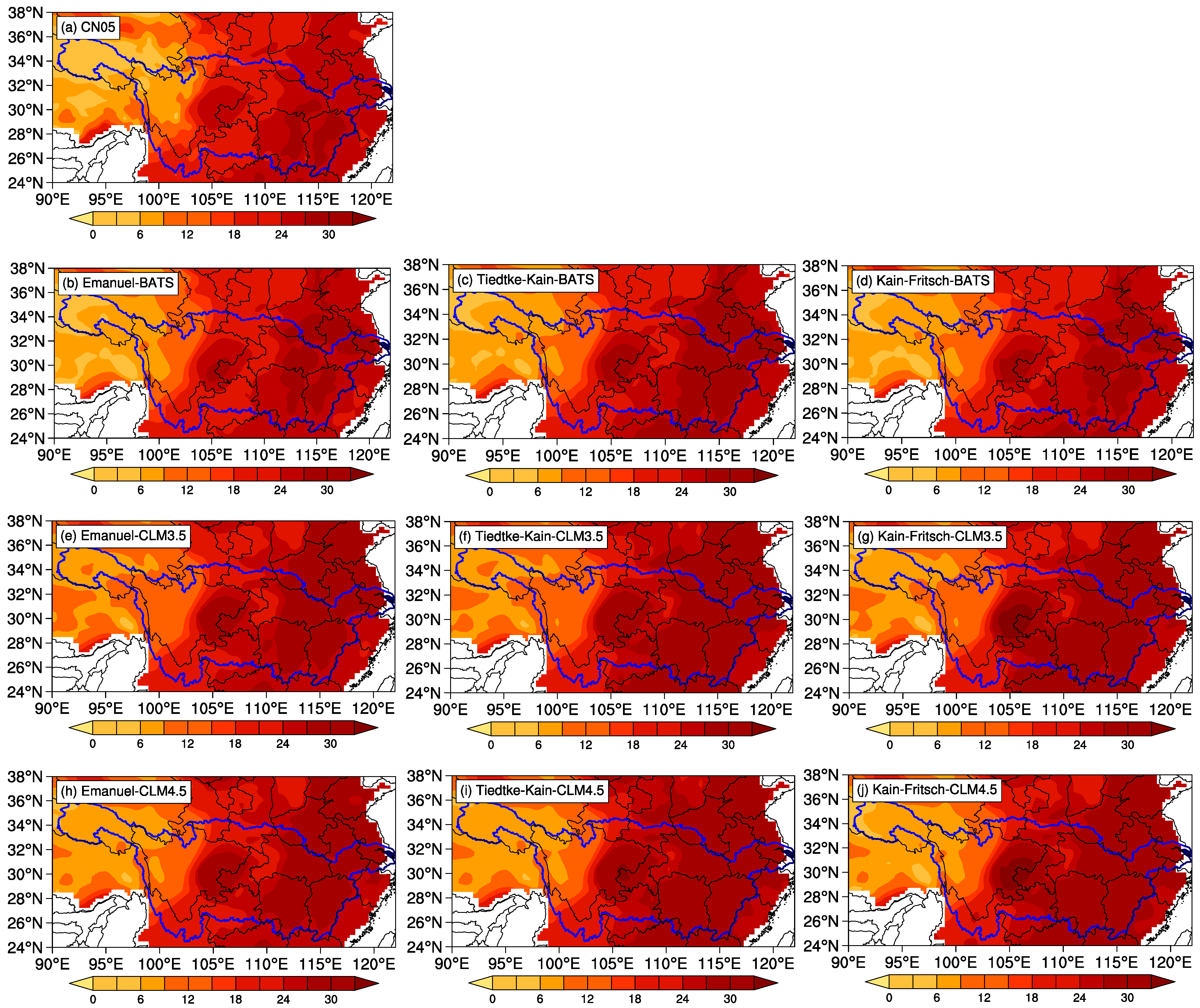
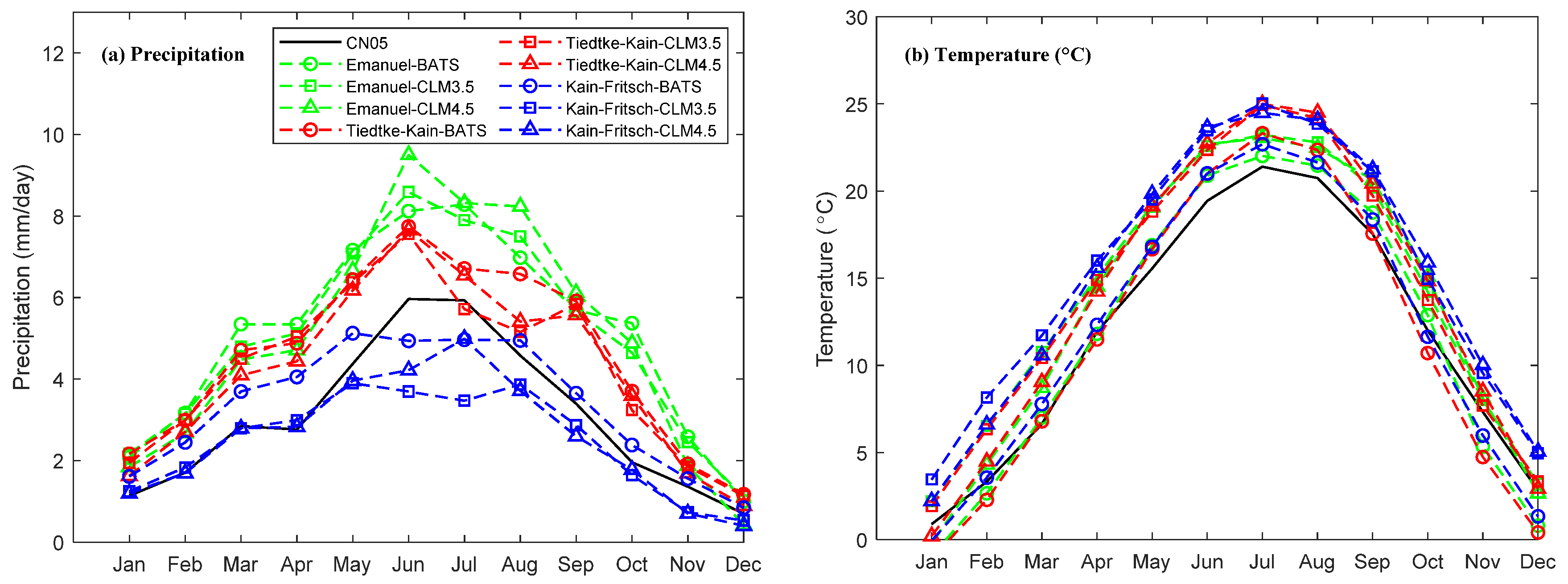
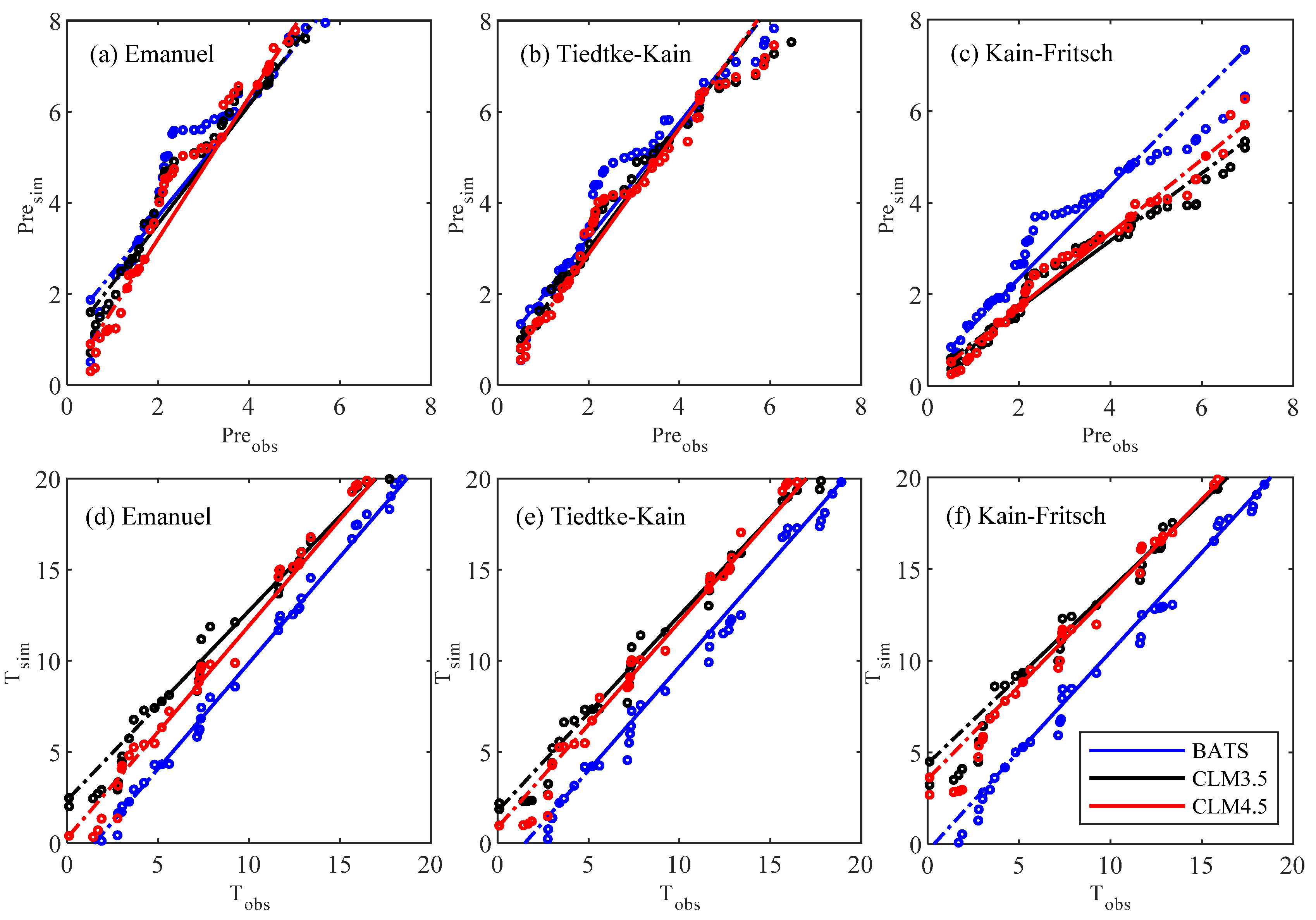
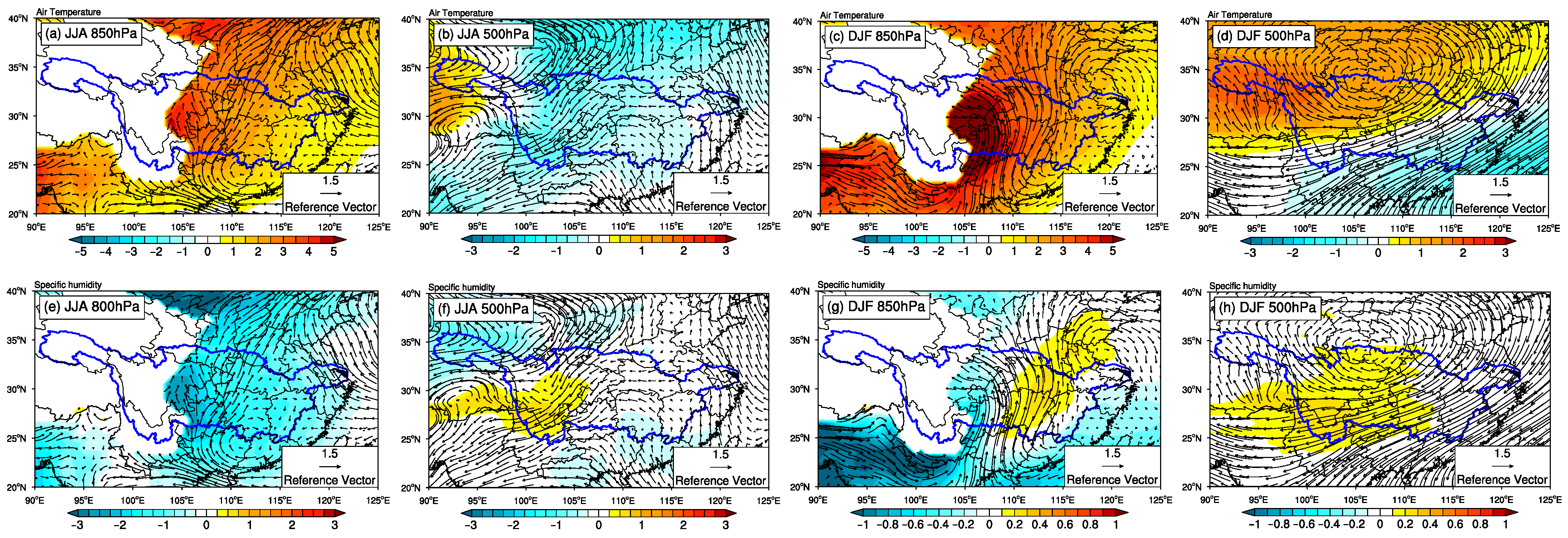
| No. | LCS | OCS | LSP | No. | LCS | OCS | LSP | No. | LCS | OCS | LSP |
|---|---|---|---|---|---|---|---|---|---|---|---|
| 1 | K | K | BATS | 25 | K | K | CLM3.5 | 49 | K | K | CLM4.5 |
| 2 | G-AS | G-AS | BATS | 26 | G-AS | G-AS | CLM3.5 | 50 | G-AS | G-AS | CLM4.5 |
| 3 | G-AS | E | BATS | 27 | G-AS | E | CLM3.5 | 51 | G-AS | E | CLM4.5 |
| 4 | G-AS | T | BATS | 28 | G-AS | T | CLM3.5 | 52 | G-AS | T | CLM4.5 |
| 5 | G-AS | KF | BATS | 29 | G-AS | KF | CLM3.5 | 53 | G-AS | KF | CLM4.5 |
| 6 | G-FC | G-FC | BATS | 30 | G-FC | G-FC | CLM3.5 | 54 | G-FC | G-FC | CLM4.5 |
| 7 | G-FC | E | BATS | 31 | G-FC | E | CLM3.5 | 55 | G-FC | E | CLM4.5 |
| 8 | G-FC | T | BATS | 32 | G-FC | T | CLM3.5 | 56 | G-FC | T | CLM4.5 |
| 9 | G-FC | KF | BATS | 33 | G-FC | KF | CLM3.5 | 57 | G-FC | KF | CLM4.5 |
| 10 | E | G-AS | BATS | 34 | E | G-AS | CLM3.5 | 58 | E | G-AS | CLM4.5 |
| 11 | E | G-FC | BATS | 35 | E | G-FC | CLM3.5 | 59 | E | G-FC | CLM4.5 |
| 12 | E | E | BATS | 36 | E | E | CLM3.5 | 60 | E | E | CLM4.5 |
| 13 | E | T | BATS | 37 | E | T | CLM3.5 | 61 | E | T | CLM4.5 |
| 14 | E | KF | BATS | 38 | E | KF | CLM3.5 | 62 | E | KF | CLM4.5 |
| 15 | T | G-AS | BATS | 39 | T | G-AS | CLM3.5 | 63 | T | G-AS | CLM4.5 |
| 16 | T | G-FC | BATS | 40 | T | G-FC | CLM3.5 | 64 | T | G-FC | CLM4.5 |
| 17 | T | E | BATS | 41 | T | E | CLM3.5 | 65 | T | E | CLM4.5 |
| 18 | T | T | BATS | 42 | T | T | CLM3.5 | 66 | T | T | CLM4.5 |
| 19 | T | KF | BATS | 43 | T | KF | CLM3.5 | 67 | T | KF | CLM4.5 |
| 20 | KF | G-AS | BATS | 44 | KF | G-AS | CLM3.5 | 68 | KF | G-AS | CLM4.5 |
| 21 | KF | G-FC | BATS | 45 | KF | G-FC | CLM3.5 | 69 | KF | G-FC | CLM4.5 |
| 22 | KF | E | BATS | 46 | KF | E | CLM3.5 | 70 | KF | E | CLM4.5 |
| 23 | KF | T | BATS | 47 | KF | T | CLM3.5 | 71 | KF | T | CLM4.5 |
| 24 | KF | KF | BATS | 48 | KF | KF | CLM3.5 | 72 | KF | KF | CLM4.5 |
| Characteristics of Climate Variables | Statistical Indices | Weights |
|---|---|---|
| Mean value | RE (%) | 1.0 |
| Standard deviation | RE (%) | 1.0 |
| Temporal change | NRMSE | 1.0 |
| Monthly distribution | Correlation coefficient (R2) | 1.0 |
| Spatial distribution | Correlation coefficient (R2) | 1.0 |
| Spatiotemporal variability | EOF1 (first vector) | 0.5 |
| EOF2 (second vector) | 0.5 | |
| Probability density functions | BS | 0.5 |
| Sscore | 0.5 |
| Month | Precipitation (mm/Day) | Evaporation (mm/Day) | SM (kg/m2) | SH (W/m2) | ||||
|---|---|---|---|---|---|---|---|---|
| CLM3.5 | CLM4.5 | CLM3.5 | CLM4.5 | CLM3.5 | CLM4.5 | CLM3.5 | CLM4.5 | |
| 1 | −0.37 | −0.44 | −0.47 | −0.43 | −10.29 | −8.77 | 2.35 | −3.49 |
| 2 | −0.65 | −0.79 | −0.62 | −0.66 | −10.24 | −9.91 | 5.48 | 1.81 |
| 3 | −0.96 | −0.96 | −0.92 | −0.87 | −8.48 | −9.53 | 13.28 | 8.58 |
| 4 | −1.06 | −1.26 | −1.18 | −1.11 | −8.72 | −10.43 | 14.49 | 12.35 |
| 5 | −1.25 | −1.30 | −1.27 | −1.09 | −8.46 | −10.69 | 13.75 | 8.01 |
| 6 | −1.25 | −0.76 | −1.42 | −1.25 | −5.81 | −7.92 | 7.20 | −0.57 |
| 7 | −1.52 | 0.05 | −1.45 | −1.05 | −5.92 | −6.92 | 8.30 | −0.68 |
| 8 | −1.09 | −1.21 | −1.30 | −1.16 | −5.68 | −7.49 | 6.28 | 4.12 |
| 9 | −0.78 | −1.07 | −1.25 | −1.35 | −5.76 | −7.26 | 8.30 | 11.45 |
| 10 | −0.77 | −0.67 | −1.17 | −1.27 | −6.10 | −6.88 | 9.91 | 11.55 |
| 11 | −0.87 | −0.91 | −0.98 | −1.07 | −8.55 | −7.58 | 7.41 | 5.82 |
| 12 | −0.30 | −0.45 | −0.68 | −0.76 | −9.51 | −7.29 | 2.58 | −0.49 |
| Mean | −0.37 | −0.44 | −1.06 | −1.01 | −7.79 | −8.39 | 8.28 | 4.87 |
Disclaimer/Publisher’s Note: The statements, opinions and data contained in all publications are solely those of the individual author(s) and contributor(s) and not of MDPI and/or the editor(s). MDPI and/or the editor(s) disclaim responsibility for any injury to people or property resulting from any ideas, methods, instructions or products referred to in the content. |
© 2024 by the authors. Licensee MDPI, Basel, Switzerland. This article is an open access article distributed under the terms and conditions of the Creative Commons Attribution (CC BY) license (https://creativecommons.org/licenses/by/4.0/).
Share and Cite
Yan, S.; Li, B.; Du, L.; Wang, D.; Huang, Y. Simulation Performance of Temperature and Precipitation in the Yangtze River by Different Cumulus and Land Surface Schemes in RegCM4. Atmosphere 2024, 15, 334. https://doi.org/10.3390/atmos15030334
Yan S, Li B, Du L, Wang D, Huang Y. Simulation Performance of Temperature and Precipitation in the Yangtze River by Different Cumulus and Land Surface Schemes in RegCM4. Atmosphere. 2024; 15(3):334. https://doi.org/10.3390/atmos15030334
Chicago/Turabian StyleYan, Sheng, Bingxue Li, Lijuan Du, Dequan Wang, and Ya Huang. 2024. "Simulation Performance of Temperature and Precipitation in the Yangtze River by Different Cumulus and Land Surface Schemes in RegCM4" Atmosphere 15, no. 3: 334. https://doi.org/10.3390/atmos15030334
APA StyleYan, S., Li, B., Du, L., Wang, D., & Huang, Y. (2024). Simulation Performance of Temperature and Precipitation in the Yangtze River by Different Cumulus and Land Surface Schemes in RegCM4. Atmosphere, 15(3), 334. https://doi.org/10.3390/atmos15030334








